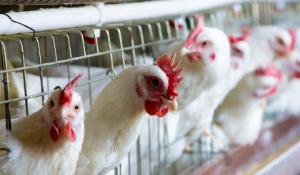- Posted by Anitox
The Ultimate Guide to Understanding Necrotic Enteritis
Six billion dollars. That’s the estimate of what poultry producers spend annually on necrotic enteritis prevention, treatment and losses. Why so much?
Efficient production requires that birds derive nutrients from feed to optimize growth and that their environment, health and welfare are managed to maximize their ability to convert those nutrients via digestion. Necrotic Enteritis is a condition that significantly impedes their ability to do so efficiently.
Keeping layer feed free from pathogens results in improved flock uniformity, improved feed conversion rates/egg numbers and reduced mortality.
What is Necrotic Enteritis?
Necrotic enteritis is a poultry disease that occurs when areas of the intestinal epithelium die within the gastrointestinal tract. There are two forms of the disease, each responsible for slightly different consequences.
The clinical form of necrotic manifests in:
- Severe bird depression
- The 3 D’s: diarrhea, dehydration and decreased feed consumption
- Ruffled feathers
- Reluctance to move
In its subclinical form, birds may demonstrate a reduced appetite. A damaged intestinal mucosa leads to:
- Decreased digestion
- Increased FCR
- Weight Loss or slow weight gain
Causes of Necrotic Enteritis

Necrotic enteritis doesn’t spontaneously appear. It requires predisposing factors. In other words, for a Clostridium perfringens infection to cause necrotic enteritis, certain conditions in the bird must be met. Clostridium perfringens thrives in an environment plentiful in specific amino acids and vitamins – making a disrupted gastrointestinal tract prime real estate. Prerequisites for C. perfringens competitive advantage fall into four categories:
-
Physical changes in the gut
Certain ingredients, such as cereal grains, contain non-starch polysaccharides, which are more viscous in the gut and slow digestion. More time and exceptional nutrients create a great growing environment for anaerobic bacteria. Any physical damage or change to the gut can potentially allow C. perfringens to access the basal layer, extracellular molecules, plasma and digestive mucus - all of which benefit C. perfringens.
- Immune status changes
Immunosuppression increases the likelihood of an infection to occur. Changes to a bird’s immunity are commonly due to physiological stress or disease onset.
- Microbiota disruption in the gastrointestinal tract
Diets can alter the microbiota, potentially allowing pathogenic C. perfringens to become more competitive within the gut.
- Prolific infection with C. perfringens
Necrotic enteritis is more likely to result in birds that are contaminated with a highly pathogenic C. perfringens.
How Does the Gut Become Necrotic?
Defined, necrotic means a localized area of living tissue has died. For this to occur in a case of necrotic enteritis, the bird has experienced one or more of the prerequisites resulting in intestinal injury.
When injured, the intestine undergoes increased mucus production to protect itself. Pathogenic Clostridium perfringens within the bird uses the nutrients supplied by the mucosal barrier to replicate until it can colonize the intestine. Once established in the intestinal tract, Clostridium perfringens produces toxins, twelve of which research has linked to necrotic enteritis. These toxins work by creating holes in the cell membranes of intestinal tissues. These holes allow contents from the intestine to leak, creating areas of tissue death, altering the digestive landscape and impairing nutrient absorption and growth.
How Can Necrotic Enteritis be Prevented?
Necrotic enteritis prevention is two-fold. The first step is to prevent bird health conditions in which Clostridia perfringens can thrive and produce toxins. In the past antibiotic growth promoters were used to prevent precursor infections, such as coccidiosis. However, the antibiotic-free movement has pushed producers to take a more holistic approach to preventative action.
This includes:
- Lower density housing
- Vaccination programs
- Poultry house ventilation
- Diet formulations
The second part of necrotic enteritis prevention is the reduced prevalence of pathogenic Clostridium perfringens within live production. Commonly found in the natural environment, Clostridia are prevalent in feed and its ingredients. In fact, research from one study found 84% of mixed feed samples to be contaminated with Clostridium perfringens.
Reduction of Clostridium perfringens prevalence in operations can be managed by robust biosecurity and hygiene efforts, including:
- Litter management
- Feed Sanitation
Recognizing feed as a fomite is one way to reduce the prevalence of Clostridium perfringens within poultry operations. Feed pathogen control provides poultry feed safety.
The study, Evaluation of the Epithelial Barrier Function and Ileal Microbiome in an Established Necrotic Enteritis Challenge Model in Broiler Chickens, examined the ability of Salmonella typhimurium, Eimeria maxima and Clostridium perfringens to create the conditions in which necrotic enteritis could develop. Birds were reared until day 25 on which they were assessed for lesions. Throughout the 25 days, researchers exposed the birds sequentially to the three pathogens, S. typhimurium on day 1, E. maxima on day 18 and C. perfringens on days 23 and 24. On day 23 12.5% of the exposed birds demonstrated reduced activity. By day 25, after exposure to all three pathogens, 100% of the bird’s clinical signs of necrotic enteritis, whereas no clinical signs were observed in the un-exposed bird population. This research models how pathogens can work synergistically to disrupt intestinal homeostasis and cause disease.
.png?width=300&name=Copy%20of%20Add%20a%20subheading%20(2).png) Feed containing a high microbial load, and likely feed pathogens, can introduce the risk of pathogen exposure to the intestinal microflora, potentially creating a disturbance capable of inducing necrotic enteritis. However, feed pathogen control in the form of feed sanitizers keeps feed clean from mill to feeder, reducing pathogen prevalence in live production and promoting poultry feed safety.
Feed containing a high microbial load, and likely feed pathogens, can introduce the risk of pathogen exposure to the intestinal microflora, potentially creating a disturbance capable of inducing necrotic enteritis. However, feed pathogen control in the form of feed sanitizers keeps feed clean from mill to feeder, reducing pathogen prevalence in live production and promoting poultry feed safety.
To learn more about feed as a fomite or learn how feed sanitation can enhance your necrotic enteritis prevention efforts download our Enteritis guide today.

